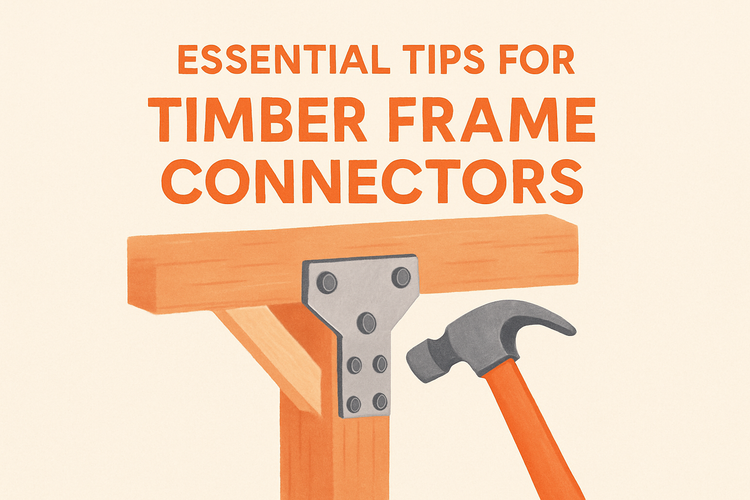Essential Tips For Timber Frame Connectors

Selecting the Right Timber Frame Connector for Your Project
Choosing the correct timber frame connector depends on your structural requirements and the type of load the frame will bear. Before purchasing, always consider the material, size, and intended application.
Each connector plays a specific role in maintaining the integrity of your timber structure. For example, [Joist Hangers](https://jandeconstruction.co.uk/collections/joist-hangers) are ideal for securing horizontal timbers like floor joists and ceiling beams, ensuring even distribution of weight. On the other hand, [Post Bases](https://jandeconstruction.co.uk/collections/post-base) are essential for anchoring vertical posts and providing moisture and corrosion resistance, especially in outdoor environments.
When selecting connectors, consider whether you'll need added resistance against environmental conditions such as high winds or seismic activity. Heavy-duty [High Wind Ties & Timber Connectors](https://jandeconstruction.co.uk/collections/high-wind-ties-timber-connectors) offer enhanced security and can be critical in exposed locations. Also, check the manufacturing standards, galvanization quality, and compatibility with your timber type for optimal strength and durability.
Understand Load Types and Their Impact on Connector Performance
Not all loads are created equal. The type of load your timber frame is expected to bear will determine which connectors are suitable for reliable performance.
Timber connectors are engineered to manage various stresses — from vertical compression loads due to weight above, to lateral forces caused by wind or shifting soil. In high-load areas, choose components engineered to resist shear forces and uplift. [Connectors for Glulam Timber](https://jandeconstruction.co.uk/collections/connectors-for-glulam-timber) are specifically designed to support large spans and heavy loads, often found in structural or commercial constructions.
Additionally, consider tension resistance. For example, restraints and cross bracing using [Restraint Straps](https://jandeconstruction.co.uk/collections/restraint-straps) are effective at reducing movement and racking forces within the frame. Always consult load ratings and test certifications, especially when working with engineered timber products like CLT (Cross Laminated Timber).
In multi-story buildings or complex designs, distributing the weight evenly across your structure is crucial. Reinforce joint points appropriately and do not underestimate the importance of [Angle Brackets](https://jandeconstruction.co.uk/collections/angle-bracket) to support corners and timber joints under both vertical and lateral strain.
Installation Best Practices for Long-Lasting Structural Integrity
A well-installed connector ensures stability and safety. Poorly installed ones can cause premature failure and costly repairs down the line.
When installing timber frame connectors, ensure accurate alignment and pre-drilling when required to prevent splitting. For instance, [Screws and Nails](https://jandeconstruction.co.uk/collections/screws-nails) must be compatible with the connector type and wood grain orientation. Use fasteners supplied or recommended by the connector's manufacturer to maintain warranty and structural integrity.
Consistency in spacing and alignment ensures the load is evenly distributed, especially crucial in multi-connector assemblies. Additionally, always verify the tightness and grip of mechanical joints—over-torquing can compromise timber strength, while under-tightening leads to joint slippage.
Moisture control is another key factor. In damp environments, use corrosion-resistant connectors alongside proper sealing or spacing for airflow. [Post Bases](https://jandeconstruction.co.uk/collections/post-base) can elevate timber above grade, reducing direct contact with humidity and improving durability.
Ensuring Compatibility with Engineered Timber
Engineered wood products like Glulam and CLT require specific connectors that can handle their structural characteristics. Compatibility is key to prevent structural weaknesses.
Not all connectors made for solid timber can be used with engineered timber. [Connectors for Cross Laminated Timber](https://jandeconstruction.co.uk/collections/connectors-for-cross-laminated) are manufactured to accommodate the unique layering and grain direction of the wood, maintaining tight joints and providing significant load distribution. Always check the application guidelines and structural drawing specifications to choose correctly.
CLT and Glulam are also denser and may require pre-drilling or countersinking for certain screw types to avoid splitting. Precise cutting and connector positioning are essential, especially in custom-fabricated assemblies. Consult your supplier or engineer if uncertain — a mismatched connector can compromise the engineered timber’s performance.
Additionally, pay attention to expanding and contracting tolerances. Engineered timbers tend to move differently compared to traditional timber, so flexible but durable connectors like specific [Timber Frame Connectors](https://jandeconstruction.co.uk/collections/timber-frame-connectors) are recommended for long-term performance under varying conditions.
Maintaining Your Timber Connectors Over Time
Even well-installed connectors need monitoring. Routine checks help extend structural life and ensure safety.
Over time, environmental factors like moisture, temperature, and pressure can compromise even the most robust timber connectors. Especially in outdoor or coastal applications, rust, corrosion, and movement in the timber are frequent issues to watch out for. Ensure that periodic checks are part of your maintenance schedule to catch loosening, warping, or weakening in bolts and hardware.
Apply sealants or protective coatings as needed, particularly on exposed [Angle Brackets](https://jandeconstruction.co.uk/collections/angle-bracket) or [Joist Hangers](https://jandeconstruction.co.uk/collections/joist-hangers). Visually inspect anchors and bases annually, focusing on signs of wood rot, especially at ground connection points. [Post Bases](https://jandeconstruction.co.uk/collections/post-base) are particularly vulnerable where moisture meets earth and should be lifted off the ground surface where practical.
If repairs are needed, make sure to replace connectors with identical or approved alternatives to match load capacities and structural requirements. Tracking component reforms and upgrading to newer weather-resistant options will also enhance the overall lifespan and safety of your timber frame structure.
